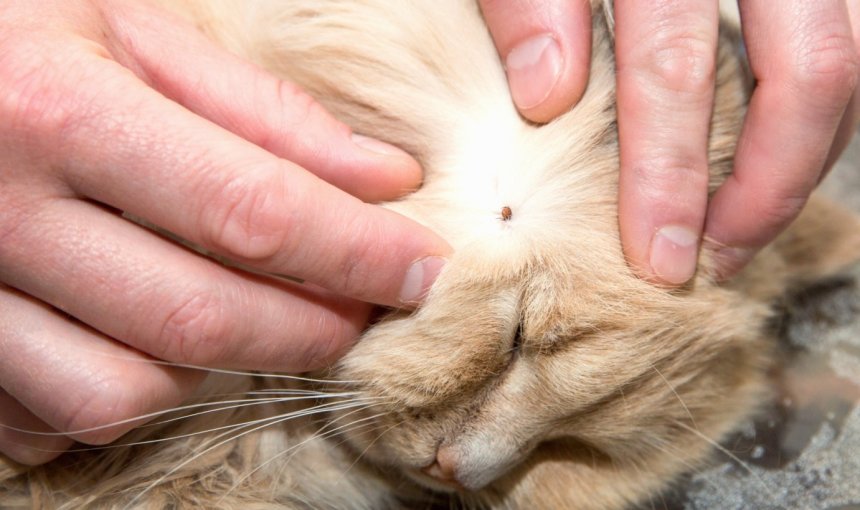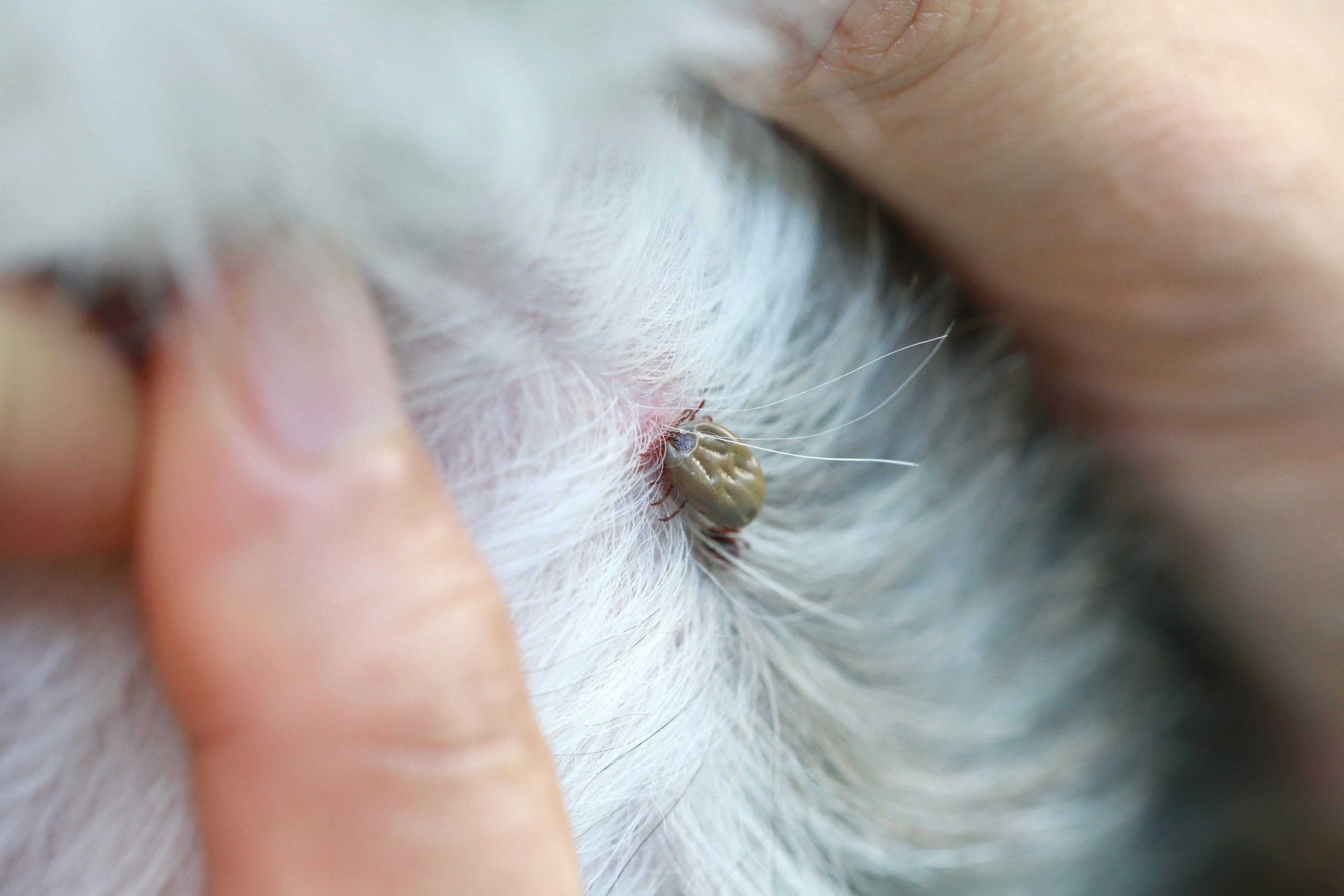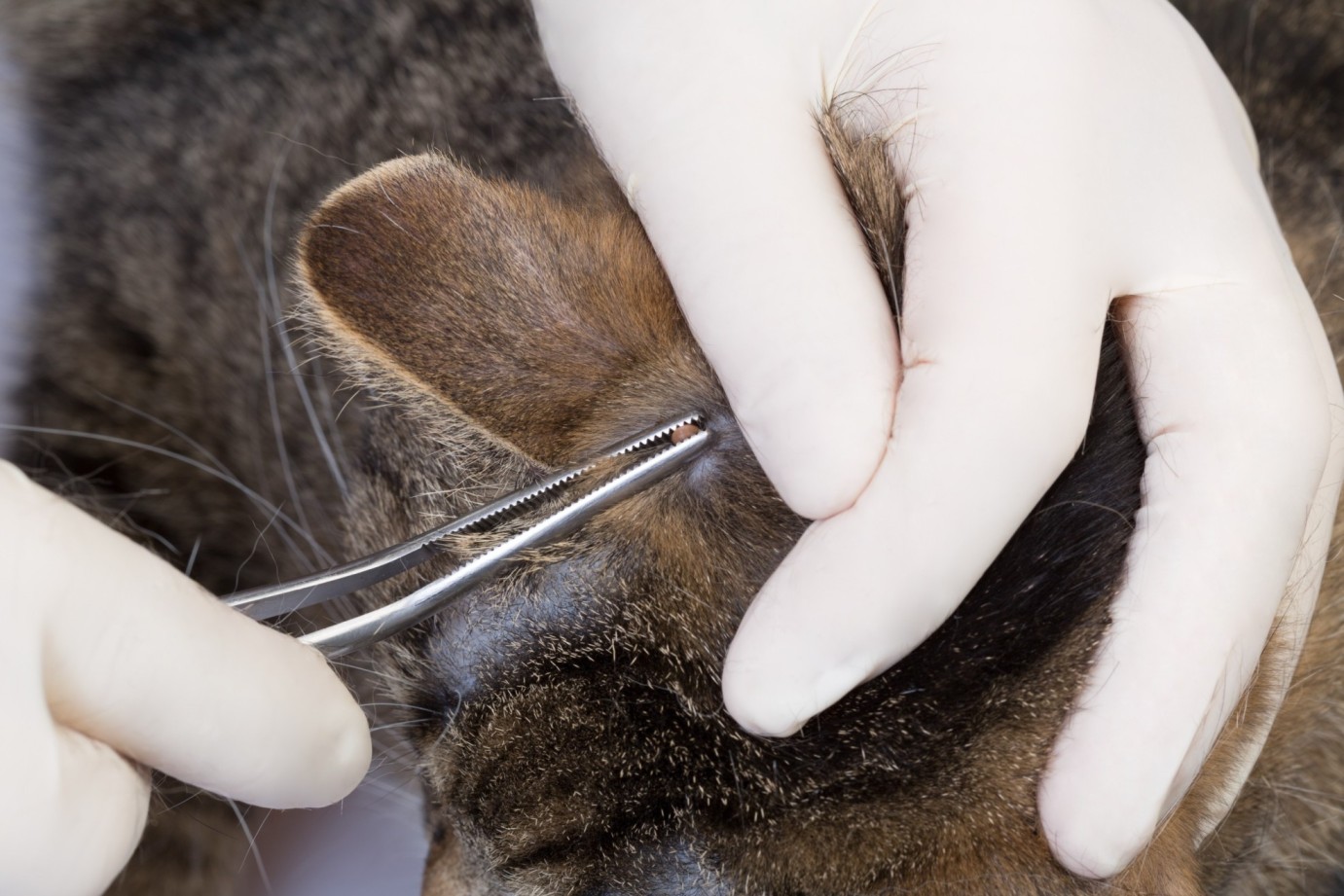 Approved by Dr. Dwight Alleyne, DVM
Approved by Dr. Dwight Alleyne, DVM How To Prevent & Get Rid Of Ticks On Cats (For Good)
Tick season is no joke...these pesky critters can affect us and our dogs and cats too! So here's how to prevent and treat ticks on cats - so you can enjoy a safe summer with your feline friend(s).

Roaming the great outdoors is one of the most enriching, fulfilling experiences your cat can experience. Until they come back home covered in fleas, mites, and – worst of all – ticks. Here’s how to handle ticks on cats – and how a smart cat collar can prevent them from wandering somewhere potentially infectious.
Key Takeaways
Ticks are tiny bugs that can get on your cat from grassy or wooded areas. Check your cat by patting them all over, feeling for tiny bumps, especially on their head, neck, ears, and feet.
If you find a tick attached to your cat, remove it right away using tweezers or a special tool. Make sure to pull the entire bug out. If you’re nervous or can’t get it all out, call your vet for help.
To prevent ticks, use a product approved by your vet, like a monthly spot-on treatment or a tick spray. Also, be sure to keep your grass trimmed and treat your yard.
Since outdoor cats are at a higher risk of picking up ticks, you can use the Tractive smart cat collar to keep an eye on them. The tracker can show you a map of where your cat goes, helping you find and avoid areas that are infested with ticks.

Find out where your cat spends their time.
Read more- Key Takeaways
- What are ticks and what do they look like?
- How do cats get ticks?
- What do ticks look like on cats?
- Symptoms of ticks on cats
- What diseases can cats get from tick bites?
- How to check for ticks on cats
- What to do if you find a tick on your cat?
- How to remove a tick from a cat
- How to prevent ticks on cats (and get rid of them for good)
- Should you use a tick collar?
- Where a smart cat collar can help
What are ticks and what do they look like?
Ticks are tiny parasites that are related to spiders. (In fact, they even belong to a group called arachnids.) They have eight legs, are oval-shaped, and they can be as small as a poppy seed. These creatures feed on the blood of the animal they have landed on by embedding their mouthparts in the host’s skin.
A tick may remain attached to the host for several days, ingesting blood and swelling to about the size of a small pea, then dropping off. While attached to the host, microbes within the tick can be transferred into the bloodstream of the host. Some of these microbes can cause disease.
How do cats get ticks?
Ticks live in wooded or grassy areas such as forests, fields, and meadows. So if your cat spends any time outdoors, they may encounter ticks. These critters can’t fly or jump. Instead, they sit on the tips of grasses and plants and wait for an animal (such as your cat) to pass by. As your cat brushes against the vegetation, the tick grabs onto your cat’s fur and climbs on. The tick then makes its way toward the skin, where it attaches to the cat by biting the skin.
Ticks can also get onto your cat from another animal that they encounter when they are roaming outside. Which could be other cats, other pets, woodland animals, or even larger predators. If you walk outdoors a lot, check yourself for ticks on returning home – you could pass the tick onto your cat.
💡A smart cat collar can help you figure out where your cat might be hanging out throughout the day – including any tick-infested spots or patches of woodland near you.

Track your cat wherever they go
Get real-time location information, wherever they go. Find out when they go somewhere they shouldn’t, with Virtual Fences. And discover their favorite spots with Territory.
What do ticks look like on cats?
Generally, a tick on a cat should be big enough to spot1. You can check for ticks on cats by running your hands along your cat’s body when they come inside after being outdoors. If your cat has a tick, it will feel like a small nub on your cat’s skin. Upon closer inspection, a tick on a cat looks like so:

What are the different types of ticks?
There are over 800 species of ticks worldwide – but only a dozen or so are associated with disease in cats1. There are 15 species of ticks in US. The most common are:
- The American dog tick
- Lone star tick
- Deer or black-legged tick
- and the brown dog tick
Symptoms of ticks on cats
If a tick bites your cat, you might observe itching, redness or irritation at the bite site. If no disease is transmitted from tick to cat, then the actual tick on your cat is the only symptom you can look for. However, if your cat shows any of the following symptoms, they may be suffering from a tick-borne illness:
- Lethargy
- Diminished appetite
- Fever
- Stiff or swollen joints1
What diseases can cats get from tick bites?
Tick-borne diseases in cats are rare, but they can occur. The diagnosis is made by noting the symptoms that the cat is experiencing and the fact that the cat had a tick bite.
- Lyme disease is well-known as a tick-borne disease in humans. It is unlikely to occur in cats, but it can happen. There is no vaccine for Lyme disease, but if a cat is diagnosed early, the infection can be treated with antibiotics.
- Tularemia or rabbit fever is an uncommon infection in cats. It can be transmitted through tick bites or if a cat eats an infected rabbit.
- Cytauxzoonosis, also known as bobcat fever, is a tick-borne illness most often seen in wild bobcats, but it can affect all types of cats.
Not all of these diseases are present in all parts of the world, but the resulting suffering your poor cat might go through is never worth it.
How to check for ticks on cats
You’ll probably feel a tick before you see it on your cat, because a cat’s dense fur makes it hard to find a tick. Run your hands over your cat’s entire body each evening after they have been outdoors. Feel for small bumps on the skin. Ticks are usually found on a cat’s head, neck, ears, or feet. Check between your cat’s toes and ears too.
What to do if you find a tick on your cat?
Even if disease transmission is unlikely, you still want to remove the tick from your cat and dispose of it properly so it doesn’t drop off and bite you or another person or pet in the household. Here’s what to do if you find a tick on your cat.
- If the tick is NOT attached to the skin
Put on gloves, pick the tick off (with fingers or tweezers), and kill it immediately. Drop the tick in a jar of rubbing alcohol or bleach to kill it instantly. Ticks can survive being flushed down the toilet or even going through the washer and dryer! Also make sure to disinfect any items that touched the tick. Wash your hands thoroughly after. - If the tick is attached to the skin
Use gloves and get someone else to hold your cat. Keep some antiseptic wipes or rubbing alcohol ready, plus a container to put the tick in after removal.
How to remove a tick from a cat
Put on your gloves and have another person hold the cat snugly. Separate the fur to get a good view of the tick. Position the tool around the tick’s body, close to the cat’s skin. Pull the tool carefully to dislodge the tick. Go slowly. Double check that the mouthparts are on the tick and did not remain in your cat’s skin.
Put the tick in the container with rubbing alcohol. Keep the tick for a few days. If your cat develops an illness, it may be useful to have the tick available for identification by your veterinarian.
Disinfect your tick removal tool and wash your hands thoroughly. Contact your vet if you have questions or suspect an illness after seeing ticks on your cat. A tick typically needs to be attached to your cat for more than 24 hours to transmit infections such as Lyme disease.

How to prevent ticks on cats (and get rid of them for good)
No one wants to have ticks on their pets or on themselves. You have many tick prevention options to keep your cat safe from tick bites.
- Brush regularly
Be extra mindful of your outdoor cat’s grooming routine. Brushing them can help you find ticks and remove any that haven’t attached yet. - Spot-on treatments
These liquid medications are applied monthly onto your cat’s skin. When a tick ingests your cat’s blood, the medication kills the tick rapidly. - Tick shampoos
Inexpensive, easily available at your pharmacy, but require you to give your cat a bath every two weeks. The shampoo kills ticks on contact. - Tick powders
These treatments kill and repel ticks. Make sure you purchase a product meant for ticks and fleas, not just fleas. To apply, rub the fine dust onto the cat’s skin. Keep the powder away from your eyes and your cat’s eyes. Apply weekly. - Tick sprays
Another cat tick treatment is a spray purchased over the counter. These sprays kill ticks quickly and provide residual protection. This could be an option if your cat spends significant time outdoors. - Treat your house and lawn
Keep grass, shrubs, and trees trimmed to prevent ticks from gathering in heavy vegetation. Use household and yard sprays to treat your entire dwelling and yard. Just be aware that these products can harm humans, other animals, and even fish (through runoff.) - Talk to your vet
Your veterinarian is an invaluable source of advice and can help you sort through the pros and cons of each treatment. If you have small children at home, you may need to keep a recently-treated cat away from them after applying the treatment. Similarly, never use tick products meant for a dog on your cat. They can be toxic and cause seizures.
Should you use a tick collar?
These collars also protect against fleas by letting out a poisonous gas that prevents ticks from latching on. But there are a couple of reasons why a flea or anti-tick collar might not be the best option.
These kinds of collars can get caught on branches or fences and cause your cat to get hurt or stuck. LIkewise, the toxic gases they emit might kill pests – but also make your cat very sick from poisoning instead. Finally, flea or anti-tick collars might be able to keep pests off of your cat’s head – but not the rest of their body.
Where a smart cat collar can help
Finding a tick on your cat is never a pleasant surprise, and if it keeps happening, you need to figure out where your cat is picking them up. Ticks love specific environments like tall grass and wooded areas. A Tractive smart cat tracker can help you figure out exactly where these are – so you can avoid them in the future.
Strapped to your cat’s collar, you can now check the Tractive app’s Location History to see exactly where they spend their time. The Heatmap feature will highlight the specific bushes, overgrown corners, or grassy patches where your cat hangs out the most. If you keep finding ticks, those are likely the “high-risk zones” where they are encountering the pests. Knowing this allows you to trim back foliage, treat that area, or start discouraging your cat from visiting that spot.

Sometimes, your cat might pick up a tick during a brief, sneaky adventure. Your Tractive device’s real-time GPS tracking lets you follow their every move when they are out. If you suspect they’ve crossed into a wooded area or a neighbor’s unkempt garden, you can intervene immediately, reducing their exposure time.
This way, you can figure out the exact source of the problem, manage your cat’s environment, and keep them tick-free.
Your furry friend’s health and wellbeing means as much as to us as it does to you. So we’ve made it a priority to only share medically-relevant content on our blog. This post was checked, double-checked, and medically verified by Georgia-based vet, Dr. Dwight Alleyne.

Dr. Dwight Alleyne, DVM
Originally from Long Island, New York, Dr. Alleyne began his career at a no-kill animal shelter before becoming a licensed veterinary technician. He graduated from Cornell University Veterinary College in 2006 and completed an internship at Purdue University. Now practicing in Georgia, Dr. Alleyne specializes in soft tissue surgery and ultrasounds. He also writes pet health articles on his website, “The Animal Doctor Blog” (www.anmldrblog.com).




